California’s Lost Coast is named for its rugged remoteness, limited access, and sparsely populated communities. And for coastal tribal peoples of Sinkyone, Cahto, Coast Yuki, Mattole, Nekanni, Pomo, and other neighboring lineages, this name holds a much more literal meaning.
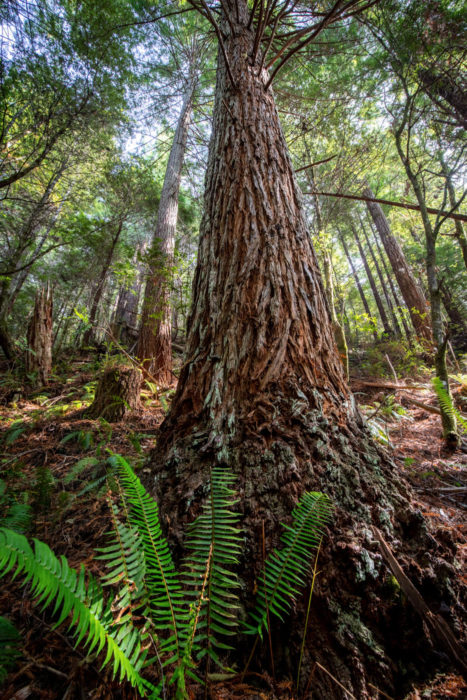
For thousands of years, Sinkyone people have lived in what is now southern Humboldt County and northern Mendocino County. Sinkyone traditional territory encompasses most of the South Fork Eel River watershed, from the vicinity of Rattlesnake Creek, north to the South Fork’s confluence with the mainstem Eel River, and then continuing along the mainstem Eel corridor north to the present-day town of Rio Dell. From those locations, the territory extends westward to the coast, from the area just south of the Mattole River to the Cottoneva Valley, and from this stretch of shoreline to around 200 nautical miles into the Pacific Ocean.
The South Fork Eel River is called Sinkyoko in Sinkyone dialects, which are part of the Na-Dené (Athabascan) languages occurring in some coastal areas of Northern California, Oregon, and Washington, throughout much of Alaska and Canada, and portions of the desert Southwest. Sinkyone and neighboring Cahto are the southernmost Na-Dené speaking tribes in California.
The word Sinkyone translates to “peoples of the South Fork Eel River.” They were a seafaring people, traveling into the open ocean in redwood canoes regarded as living beings. The Sinkyone lived in and traveled throughout coastal, mountain, and valley areas of their territory, procuring and preparing traditional foods such as acorns, kelp, seaweed, salt, salmon, deer, elk, and an abundant variety of berries, roots, bulbs, nuts, and seeds. Sinkyone descendants and other tribal peoples of the region continue to rely on these and other traditional foods. Customary to Indigenous cultures is gathering plants with great respect and care to maintain the health and abundance of ecosystems.
Starting in the mid-1800s, settlers began massacring and forcibly removing Sinkyone people from these lands they had cared for and called home since time immemorial. Within 15 years, the Sinkyone population had been severely reduced, killed through state-sanctioned murders, starvation, introduced diseases, and other atrocities. The survivors were exiled to reservations far from their homelands, some eventually becoming members of various federally recognized tribes of the region. Meanwhile, settlers began cutting down the giant redwoods, which tribes consider as relatives and sacred beings.
Despite the theft of land, displacement, and genocide, the region’s Indigenous Peoples have sustained longstanding relationships with their lands and the redwoods, called Gááhs-tcho (pronounced GAAS-cho) in the Sinkyone language and used to craft houses, clothing, baskets, canoes, and fish traps. In 1981, Minni Reeves, an elder and spiritual leader of the Chilula people who neighbor the Sinkyone, shared the significance of the redwoods to the Chilula and other Indigenous Peoples of the area: “The redwood trees are sacred. They are a special gift and reminder from the Great Creator to the human beings. The Great Creator made everything, including trees of all kinds, but he wanted to leave a special gift for his children. So he took a little medicine from each tree, he said a prayer and sang a powerful song, and then he mixed it all with the blood of our people. Then he created this special redwood tree from this medicine. He left it on Earth as a demonstration of his love for his children.”
Reeves continued,
“The redwood trees have a lot of power: they are the tallest, live the longest, and are the most beautiful trees in the world. Destroy these trees and you destroy the Creator’s love. And if you destroy that which the Creator loves so much, you will eventually destroy mankind.”
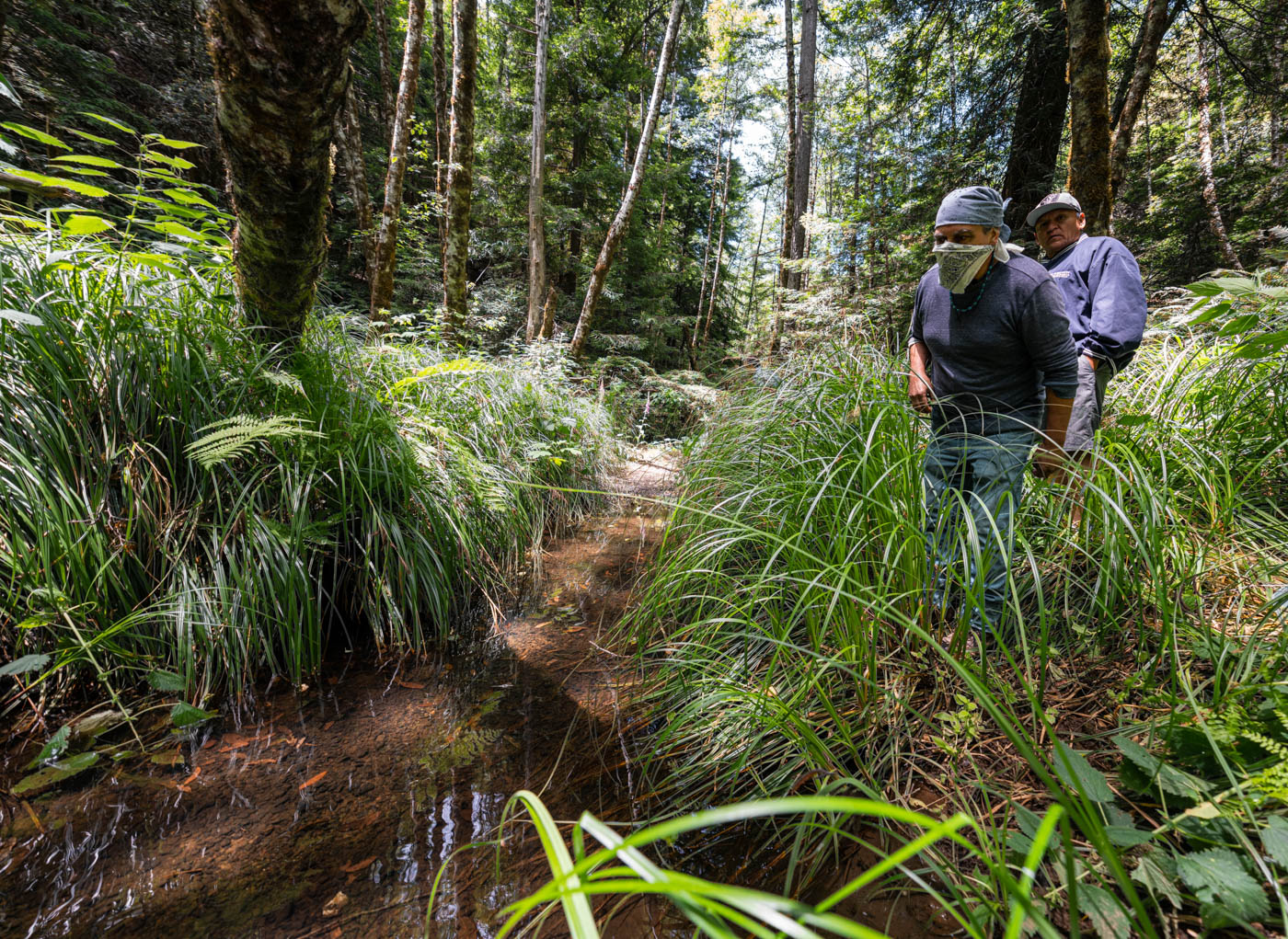
Protecting Place, Restoring Relationships
With their complex understandings of the land, based on traditional knowledge and lifeways within which redwood and other ecosystems flourished for millennia, California tribes are natural leaders and partners in land protection and conservation.
In July 2020, Save the Redwoods League acquired 523 acres of lush redwood forestland on what is now known as the Lost Coast, in the heart of traditional Sinkyone territory. In this beautiful, abundant, and rugged coastal conifer forest formerly known as Andersonia West, more than 200 acres of old-growth coast redwoods still tower among healthy younger redwoods, Douglas-firs, tanoaks, and Pacific madrones over a vibrant understory of huckleberries, manzanitas, and ceanothuses.
The League could think of no better partner in the permanent protection and stewardship of this land than the InterTribal Sinkyone Wilderness Council, a nonprofit consortium of 10 federally recognized tribes with cultural connections to the lands and waters of traditional Sinkyone and neighboring tribal territories. The Sinkyone Council consists of Cahto Tribe of Laytonville Rancheria, Coyote Valley Band of Pomo Indians, Hopland Band of Pomo Indians, Pinoleville Pomo Nation, Potter Valley Tribe, Redwood Valley Little River Band of Pomo Indians, Robinson Rancheria of Pomo Indians, Round Valley Indian Tribes, Scotts Valley Band of Pomo Indians, and Sherwood Valley Rancheria of Pomo Indians.
Having donated the nearby 164-acre Four Corners property to the Sinkyone Council in 2012, with the League holding a conservation easement there, the League proposed a donation of Andersonia West to the Sinkyone Council. The Council formally accepted the League’s offer of the donation in 2020 and granted the League a conservation easement in 2021 to continue our permanent partnership, which secures the health and the future of these lands together.
The Sinkyone Council has redesignated the land with the original Sinkyone place name: Tc’ih-Léh-Dûñ (pronounced tsih-ih-LEY-duhn), which translates to Fish Run Place. Restoring this place name in the Sinkyone language is an act of cultural empowerment and celebrates Indigenous resilience.
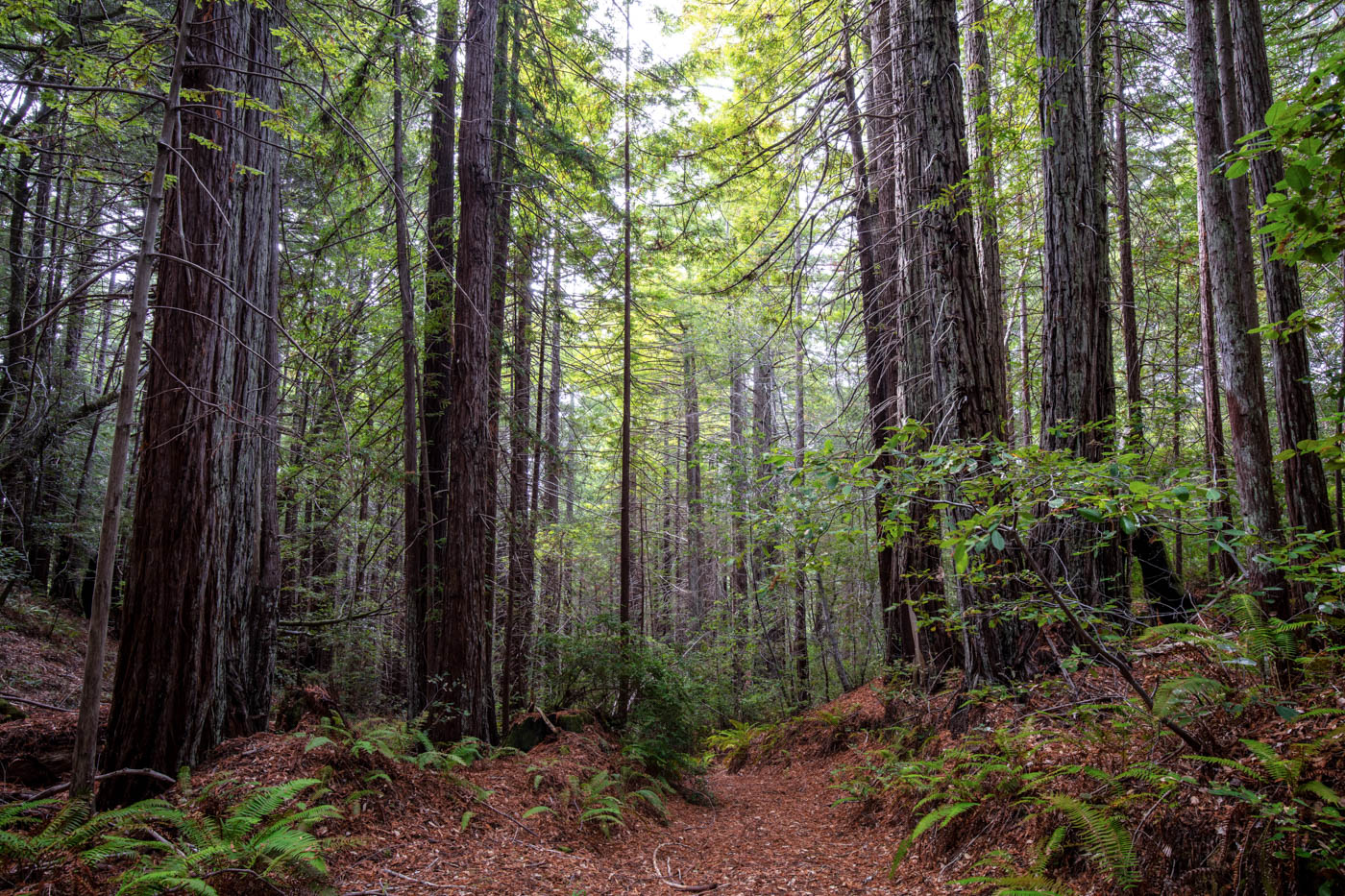
Safeguarding Nature for Nature’s Sake
Tc’ih-Léh-Dûñ is a critical habitat corridor in a vast network of approximately 180,000 acres of protected lands on the Lost Coast. It is adjacent to the 7,250-acre Sinkyone Wilderness State Park. The Sinkyone Council has designated Tc’ih-Léh-Dûñ as a Tribal Protected Area with emphasis on protecting the land’s natural attributes. Under the conservation easement, there will be no commercial timber operations, fragmentation, development, or public access.
Historical logging in the region severely impacted the redwood ecosystem, and with it, the health and abundance of salmonid fisheries. One-and-a-half miles of Anderson Creek is now safeguarded within Tc’ih-Léh-Dûñ, preventing habitat loss and fragmentation. The creek is a Class I stream, meaning it provides high-quality fish habitat. Anderson Creek bears endangered coho salmon and threatened steelhead trout, which tribal peoples consider to be relatives.
The forest provides habitat for the threatened northern spotted owl and the endangered marbled murrelet, as well as other species such as bald eagle, northern goshawk, and foothill yellow-legged frog. The conservation easement requires that the land be managed according to the Habitat Management Plan approved by the U.S. Fish and Wildlife Service. In addition to mapping the vegetation and wetlands, the League and the Sinkyone Council will survey for the presence of northern spotted owls, murrelets, and yellow-legged frogs every few years.
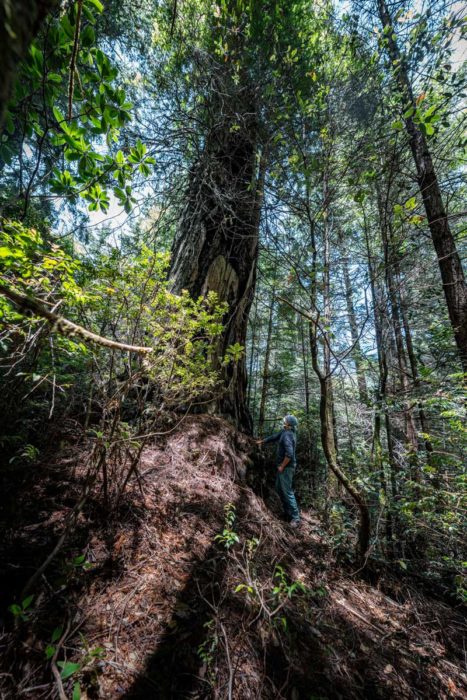
Decades of Tribal Stewardship
The Sinkyone Council sees the relationship between the region’s Indigenous Peoples and the land as a continuum. But one of the more modern movements for returning guardianship of traditional lands to local tribal people was sparked by protests to protect redwoods in 1983 at Sally Bell Grove in Sinkyone Wilderness State Park. The grove was named for a Sinkyone woman who, as a child in the 1850s, survived the slaughter of her family when settlers raided their home.
As a result of the 1980s movement, the Sinkyone Council now holds the 3,845-acre InterTribal Sinkyone Wilderness, located south of Tc’ih-Léh-Dûñ. In 1986, tribes formed the InterTribal Sinkyone Wilderness Council with the goal of acquiring these lands through a divestiture of 7,100 acres by Georgia-Pacific Corporation. In 1997 the Sinkyone Council purchased the 3,845 acres from the Trust for Public Land, permanently protecting the land from development, commercial harvesting, and fragmentation. This land is not publicly accessible, but it is dedicated to the healing of the redwood ecosystem damaged from past logging and is a place for restoration of tribal relationships with the cultural landscape.
In the process of acquiring that land, the Sinkyone Council developed educational tools and initiatives for their communities; designed and implemented fisheries restoration projects, forestry inventories, and cultural-educational programs; and developed an intertribal restoration workforce. The Council also began its important advocacy work for marine and coastal environments within Sinkyone and neighboring tribal territories. Those places are inextricably linked to the region’s redwood ecosystem in myriad cultural and biological ways.
Since its founding, the Sinkyone Council has been building capacity and expertise to steward lands and waters in the region, collaborating with a variety of project partners and always prioritizing working with and hiring tribal members for fisheries and watershed restoration, forestry work, and cultural protection initiatives. The Sinkyone Council provided tribal cultural monitors and heavy equipment operators for the multi-year Sinkyone Wilderness State Park Watershed Rehabilitation Project, in which more than 50 miles of old logging roads, landings, and stream crossings were recontoured to reduce sediment in coastal streams.
Beginning in 2009 and culminating in 2012, the Sinkyone Council and other north coast tribes successfully advocated for the California Fish and Game Commission to approve unprecedented protection of tribal traditional fishing, gathering, harvesting, and other cultural practices within specific State Marine Conservation Areas of the state’s Marine Protected Area (MPA) network. Due to the Council’s advocacy, the cultural uses of 17 federally recognized tribes were recognized in five new MPAs between the Navarro River and the southern Sinkyone coast, and the cultural uses of 18 federally recognized tribes were recognized for one MPA along the northern Sinkyone coast.
The member tribes of the Sinkyone Council will continue their robust efforts by restoring traditional stewardship at Tc’ih-Léh-Dûñ. According to former executive director Hawk Rosales, researchers cored coastal prairies in Sinkyone Wilderness State Park about 25 years ago and learned that the Sinkyone likely practiced rotational burning every five years in many coastal areas. The Council hopes to re-establish traditional burning in Tc’ih-Léh-Dûñ.
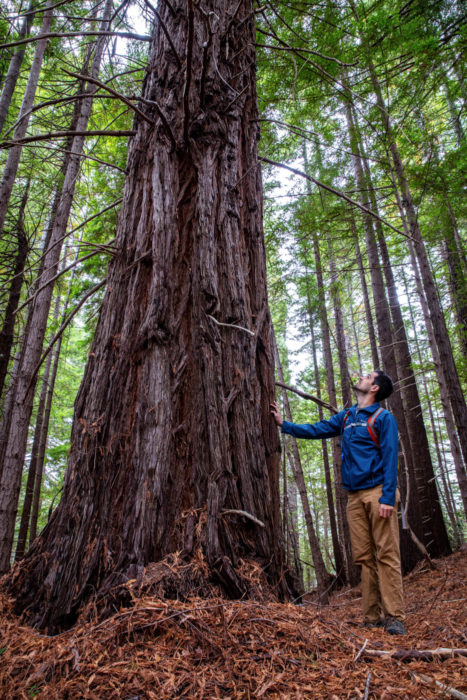
Funding Indigenous Rematriation
For several years, the League has supported tribes’ efforts to regain access to traditional lands and will continue to partner with those communities to explore ways to overcome historical hurdles to returning lands to tribes. Some of those challenges have been tribes’ oftentimes limited infrastructure, capacity, and financial resources to enable and fund land acquisition and long-term traditional stewardship.
To address this in the protection of Tc’ih-Léh-Dûñ, the League secured $3.55 million from Pacific Gas & Electric Company (PG&E) through a Habitat Acquisition and Management Agreement with the U.S. Fish and Wildlife Service to fully fund the acquisition, along with an endowment for long-term stewardship. The agreement was developed to meet PG&E’s 30-year conservation goals for the northern spotted owl and the marbled murrelet. This innovative funding strategy made this conservation project possible. It serves as a potential model for how conservation organizations can facilitate returning land to tribes—often referred to as rematriation in honor of traditional matriarchal and matrilineal societies.
The League’s partnership with the InterTribal Sinkyone Wilderness Council provides a unique opportunity to pivot to a new era of conservation. To meet the state and federal 30×30 goal of protecting 30% of lands and oceans by 2030, meaningful engagement with tribes in California is key. The League believes that the best way to permanently protect and heal this land is through tribal engagement and stewardship. In supporting a return of tribal guardianship of this place and partnering with the Council in its management and stewardship of Tc’ih-Léh-Dûñ, together we are innovating modern conservation tools based on intergenerational knowledge to restore historical balance.
Building partnerships and capacity today to support tribal ownership and co-management is critical to accelerating the pace and scale of conservation in the redwood forest. The forests are well off under the care and stewardship of the people who, like the redwoods, carry long memories of these ancient places.
Visit sinkyone.org to learn more about the work of the InterTribal Sinkyone Wilderness Council and support their work.
This feature appears in the beautiful printed edition of Redwoods magazine, a showcase of redwoods conservation stories by leading scientists and writers, as well as breathtaking photos, and ways you can help the forest. Only a selection of these stories are available online.
Join our thousands of members today for only $25, and you’ll get future editions of our Redwoods magazine.
